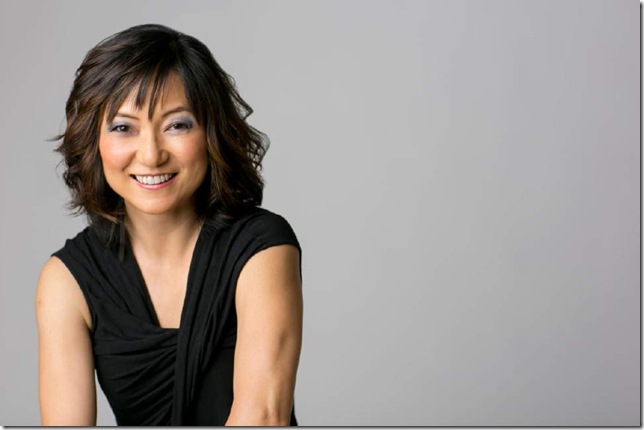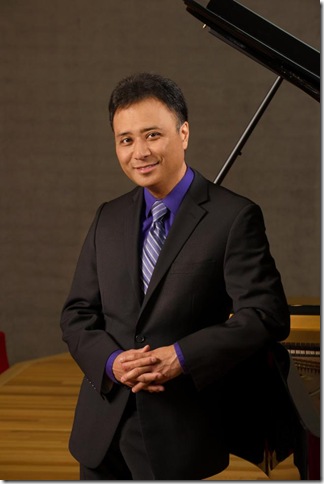March 9 marked the third concert in a series of conductor tryouts for the post of Atlantic Classical Orchestra. This time it was the turn of Rei Hotoda, associate conductor of the Utah Symphony Orchestra and a woman with credentials equal to those of the two men heard and seen on the podium so far this season.
She opened her program with Mozart’s Symphony No. 32 (in G, K. 318). It’s a one-movement work in fast-slow-fast form, like an opera overture. Composed in 1779, it is thought it might have been intended as the prelude to a stage work. Hotoda’s baton led a firm attack with her first downbeat. She has a happy presence — I liked the way she faced the violins with a smile of encouragement getting the most out of them. And when it was the turn of the violas, she did the same for them. This was a very fine reading of this early Mozart work.
Beethoven’s Fourth Piano Concerto (in G, Op. 58) 4th Piano Concerto in G followed with the distinguished soloist Jon Nakamatsu. It’s almost 20 years since he won the 1997 Van Cliburn Piano Competition’s gold medal. A German-language high school teacher, he had no formal conservatory training before the Van Cliburn, and is now a popular favorite with audiences around the world. The piano opens the work slowly and quietly, a departure from the normal orchestral exposition. Eventually, the orchestra follows the piano melody, copying it and opening it up to a grand sweeping Beethoven statement.
The pianist enters to dazzle with a series of difficult runs, nicely executed by Nakamatsu; his touch is feathery light. The oboe accompaniment sounded pinched at times, its rounded tones simply disappeared halfway through. Reacting, the pianist drew back playing softly and correctly and very precisely, as if a distant ghostly metronome had control of his hands. Horns introduce a new theme and Nakamatsu eased up on the refinement, getting some emotion into his playing, but it had that stilted feeling. Tackling a series of difficult runs next seemed to free him up, because the solo cadenza he played was amazing and quite brilliant.
The Andante con moto begins with a strong orchestral statement. Nakamatsu imbued a real depth of feeling into his playing here. Pianist and orchestra sounded great as they negotiated some difficult passages together. Hotoda kept nice tight control with an imperceptible but firm conducting technique, allowing the soloist to shine.
Delicacy was the watchword for conductor, soloist and orchestra in the closing Rondo. Nakamatsu is not a thumper, and his second cadenza flowed along like a sliver of stream water caught in the rays of the setting sun. Hotoda brought the concerto to a controlled end and the Eissey Campus Theatre audience, much larger than the first two concerts, shouted their approval.
Shostakovich’s Ninth Symphony came after intermission. Written in 1945 after the end of World War II, it was not the celebratory, grand victory symphony with chorus and soloists Stalin wanted. “I could not write an apotheosis to Stalin. I simply couldn’t,” Shostakovich said. “It’s a merry little piece. Musicians will love to play it.’’ Indeed, it is half the length of Symphonies Nos. 7 and 8, and very light and puckish.
The symphony is in five movements, and the last three merge into one another with no breaks. At its first hearing by the Leningrad Philharmonic, Hotoda told the audience, Shostakovich stood in the wings shouting, “More like circus music, please!”
Every section of the orchestra gets to show off with the first movement’s cheeky, lively tunes, and Hotoda had it all under control. The symphony sounds Haydn-like at times, but I also was reminded of Prokoviev’s Classical Symphony written in 1917. It’s a happy piece, too: was Shostakovich taking a lead from him, saying we’ve had enough of war, time for people to be happy again? There are similarities in the first movements of both symphonies.
The Moderato second movement has a yearning clarinet open with gloomy bassoons echoing his theme. Trendy violin tunes accompanied by double basses and cellos ruminate around, Soviet-style, in a dreadful slow march. Plucked strings accompany a fading piccolo; it’s all so beautiful and effective and very emotional.
The symphony returns to joy in its last pages as the orchestra races to a happy ending, which won roars of applause from the audience. A Strauss polka followed as an encore.

